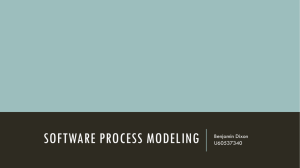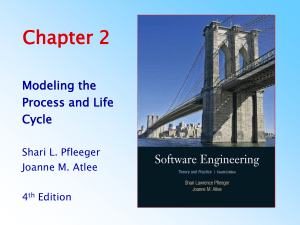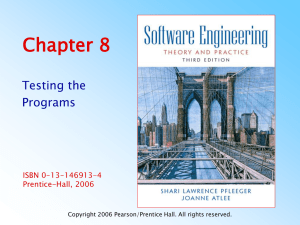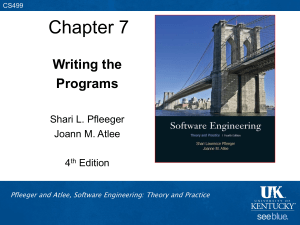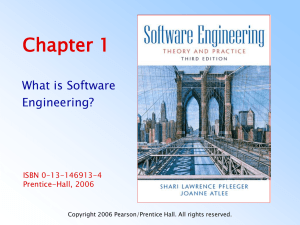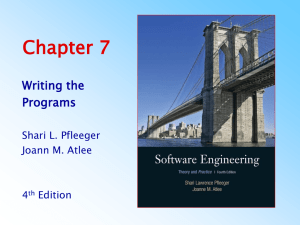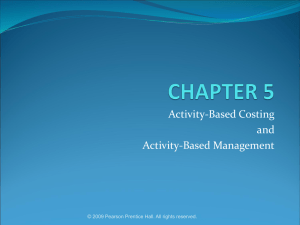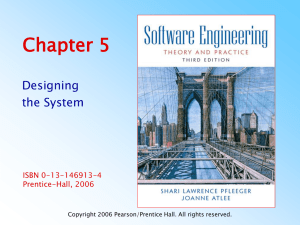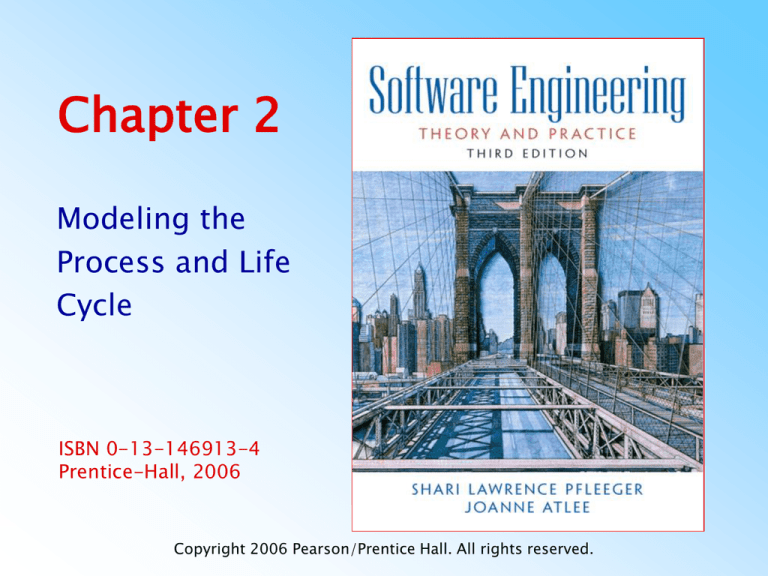
Chapter 2
Modeling the
Process and Life
Cycle
ISBN 0-13-146913-4
Prentice-Hall, 2006
Copyright 2006 Pearson/Prentice Hall. All rights reserved.
Contents
2.1
2.2
2.3
2.4
2.5
2.6
2.7
The Meaning of Process
Software Process Models
Tools and Techniques for Process Modeling
Practical Process Modeling
Information System Example
Real Time Example
What this Chapter Means for You
Pfleeger and Atlee, Software Engineering: Theory and Practice
© 2006 Pearson/Prentice Hall
Page 2.2
Chapter 2 Objectives
• What we mean by a “process”
• Software development products, processes,
and resources
• Several models of the software development
process
• Tools and techniques for process modeling
Pfleeger and Atlee, Software Engineering: Theory and Practice
© 2006 Pearson/Prentice Hall
Page 2.3
2.1 The Meaning of Process
• A process: a series of steps involving
activities, constrains, and resources that
produce an intended ouput of some kind
• A process involves a set of tools and
techniques
Pfleeger and Atlee, Software Engineering: Theory and Practice
© 2006 Pearson/Prentice Hall
Page 2.4
2.1 The Meaning of Process
Process Characteristics
• Prescribes all major process activities
• Uses resources, subject to set of constraints (such as
schedule)
• Produces intermediate and final products
• May be composed of subprocesses with hierarchy or
links
• Each process activity has entry and exit criteria
• Activities are organized in sequence, so timing is clear
• Each process has guiding principles, including goals of
each activity
• Constraints may apply to an activity, resource or
product
Pfleeger and Atlee, Software Engineering: Theory and Practice
© 2006 Pearson/Prentice Hall
Page 2.5
2.1 The Meaning of Process
The Importance of Processes
• Impose consistency and structure on a set of
activities
• Guide us to understand, control, examine, and
improve the activities
• Enable us to capture our experiences and pass
them along
Pfleeger and Atlee, Software Engineering: Theory and Practice
© 2006 Pearson/Prentice Hall
Page 2.6
2.2 Software Process Models
Reasons for Modeling a Process
• To form a common understanding
• To find inconsistencies, redundancies,
omissions
• To find and evaluate appropriate activities
for reaching process goals
• To tailor a general process for a particular
situation in which it will be used
Pfleeger and Atlee, Software Engineering: Theory and Practice
© 2006 Pearson/Prentice Hall
Page 2.7
2.2 Software Process Models
Software Life Cycle
• When a process involves building a software,
the process may be referred to as software
life cycle
–
–
–
–
–
–
Requirements analysis and definition
System (architecture) design
Program (detailed/procedural) design
Writing programs (coding/implementation)
Testing: unit, integration, system
System delivery (deployment)
– Maintenance
Pfleeger and Atlee, Software Engineering: Theory and Practice
© 2006 Pearson/Prentice Hall
Page 2.8
2.2 Software Process Models
Software Development Process Models
•
•
•
•
•
•
Waterfall model
V model
Prototyping model
Operational specification
Transformational model
Phased development: increments and
iterations
• Spiral model
• Agile methods
Pfleeger and Atlee, Software Engineering: Theory and Practice
© 2006 Pearson/Prentice Hall
Page 2.9
2.2 Software Process Models
Waterfall Model
• One of the first process development models
proposed
• Works for well understood problems with
minimal or no changes in the requirements
• Simple and easy to explain to customers
• It presents
– a very high-level view of the development process
– sequence of process activities
• Each major phase is marked by milestones
and deliverables (artifacts)
Pfleeger and Atlee, Software Engineering: Theory and Practice
© 2006 Pearson/Prentice Hall
Page 2.10
2.2 Software Process Models
Waterfall Model (continued)
Pfleeger and Atlee, Software Engineering: Theory and Practice
© 2006 Pearson/Prentice Hall
Page 2.11
2.2 Software Process Models
Waterfall Model (continued)
• There is no iteration in waterfall model
• Most software developments apply a great
many iterations
Pfleeger and Atlee, Software Engineering: Theory and Practice
© 2006 Pearson/Prentice Hall
Page 2.12
2.2 Software Process Models
Sidebar 2.1 Drawbacks of The Waterfall Model
• Provides no guidance how to handle changes
to products and activities during
development (assumes requirements can be
frozen)
• Views software development as
manufacturing process rather than as
creative process
• There is no iterative activities that lead to
creating a final product
• Long wait before a final product
Pfleeger and Atlee, Software Engineering: Theory and Practice
© 2006 Pearson/Prentice Hall
Page 2.13
2.2 Software Process Models
Waterfall Model with Prototype
• A prototype is a partially developed product
• Prototyping helps
– developers assess alternative design strategies
(design prototype)
– users understand what the system will be like
(user interface prototype)
• Protopyping is useful for verification and
validation
Pfleeger and Atlee, Software Engineering: Theory and Practice
© 2006 Pearson/Prentice Hall
Page 2.14
2.2 Software Process Models
Waterfall Model with Prototype (continued)
• Waterfall model with prototyping
Pfleeger and Atlee, Software Engineering: Theory and Practice
© 2006 Pearson/Prentice Hall
Page 2.15
2.2 Software Process Models
V Model
• A variation of the waterfall model
• Uses unit testing to verify procedural design
• Uses integration testing to verify
architectural (system) design
• Uses acceptance testing to validate the
requirements
• If problems are found during verification and
validation, the left side of the V can be reexecuted before testing on the right side is
re-enacted
Pfleeger and Atlee, Software Engineering: Theory and Practice
© 2006 Pearson/Prentice Hall
Page 2.16
2.2 Software Process Models
V Model (continued)
Pfleeger and Atlee, Software Engineering: Theory and Practice
© 2006 Pearson/Prentice Hall
Page 2.17
2.2 Software Process Models
Prototyping Model
• Allows repeated investigation of the
requirements or design
• Reduces risk and uncertainty in the
development
Pfleeger and Atlee, Software Engineering: Theory and Practice
© 2006 Pearson/Prentice Hall
Page 2.18
2.2 Software Process Models
Operational Specificiation Model
• Requirements are executed (examined) and
their implication evaluated early in the
development process
• Functionality and the design are allowed to
be merged
Pfleeger and Atlee, Software Engineering: Theory and Practice
© 2006 Pearson/Prentice Hall
Page 2.19
2.2 Software Process Models
Transformational Model
• Fewer major development steps
• Applies a series of transformations to change
a specification into a deliverable system
–
–
–
–
Change data representation
Select algorithms
Optimize
Compile
• Relies on formalism
• Requires formal specification (to allow
transformations)
Pfleeger and Atlee, Software Engineering: Theory and Practice
© 2006 Pearson/Prentice Hall
Page 2.20
2.2 Software Process Models
Transformational Model (continued)
Pfleeger and Atlee, Software Engineering: Theory and Practice
© 2006 Pearson/Prentice Hall
Page 2.21
2.2 Software Process Models
Phased Development: Increments and Iterations
• Shorter cycle time
• System delivered in pieces
– enables customers to have some functionality
while the rest is being developed
• Allows two systems functioning in parallel
– the production system (release n): currently being
used
– the development system (release n+1): the next
version
Pfleeger and Atlee, Software Engineering: Theory and Practice
© 2006 Pearson/Prentice Hall
Page 2.22
2.2 Software Process Models
Phased Development: Increments and Iterations
(continued)
Pfleeger and Atlee, Software Engineering: Theory and Practice
© 2006 Pearson/Prentice Hall
Page 2.23
2.2 Software Process Models
Phased Development: Increments and Iterations
(continued)
• Incremental development: starts with small functional
subsystem and adds functionality with each new release
• Iterative development: starts with full system, then
changes functionality of each subsystem with each new
release
Pfleeger and Atlee, Software Engineering: Theory and Practice
© 2006 Pearson/Prentice Hall
Page 2.24
2.2 Software Process Models
Phased Development: Increments and Iterations
(continued)
• Phased development is desirable for several
reasons
– Training can begin early, even though some
functions are missing
– Markets can be created early for functionality that
has never before been offered
– Frequent releases allow developers to fix
unanticipated problems globaly and quickly
– The development team can focus on different areas
of expertise with different releases
Pfleeger and Atlee, Software Engineering: Theory and Practice
© 2006 Pearson/Prentice Hall
Page 2.25
2.2 Software Process Models
Spiral Model
• Suggested by Boehm (1988)
• Combines development activities with risk
management to minimize and control risks
• The model is presented as a spiral in which
each iteration is represented by a circuit
around four major activities
–
–
–
–
Plan
Determine goals, alternatives, and constraints
Evaluate alternatives and risks
Develop and test
Pfleeger and Atlee, Software Engineering: Theory and Practice
© 2006 Pearson/Prentice Hall
Page 2.26
2.2 Software Process Models
Spiral Model (continued)
Pfleeger and Atlee, Software Engineering: Theory and Practice
© 2006 Pearson/Prentice Hall
Page 2.27
2.2 Software Process Models
Agile Methods
• Emphasis on flexibility in producing software
quickly and capably
• Agile manifesto
– Value individuals and interactions over process and
tools
– Prefer to invest time in producing working software
rather than in producing comprehensive
documentation
– Focus on customer collaboration rather than
contract negotiation
– Concentrate on responding to change rather than on
creating a plan and then following it
Pfleeger and Atlee, Software Engineering: Theory and Practice
© 2006 Pearson/Prentice Hall
Page 2.28
2.2 Software Process Models
Agile Methods: Examples of Agile Process
• Extreme programming (XP)
• Crystal: a collection of approaches based on
the notion that every project needs a unique
set of policies and conventions
• Scrum: 30-day iterations; multiple selforganizing teams; daily “scrum” coordination
• Adaptive software development (ASD)
Pfleeger and Atlee, Software Engineering: Theory and Practice
© 2006 Pearson/Prentice Hall
Page 2.29
2.2 Software Process Models
Agile Methods: Extreme Programming
• Emphasis on four characteristics of agility
– Communication: continual interchange between
customers and developers
– Simplicity: select the simplest design or
implementation
– Courage: commitment to delivering functionality
early and often
– Feedback: loops built into the various activitites
during the development process
Pfleeger and Atlee, Software Engineering: Theory and Practice
© 2006 Pearson/Prentice Hall
Page 2.30
2.2 Software Process Models
Agile Methods: Twelve Facets of XP
• The planning game
(customer defines value)
• Small releases
• Metaphor (common
vision, common names)
• Simple design
• Writing tests first
• Refactoring
• Pair programming
• Collective ownership
• Continuous integration
(small increments)
• Sustainable pace
hours/week)
(40
• On-site customer
• Coding standards
Pfleeger and Atlee, Software Engineering: Theory and Practice
© 2006 Pearson/Prentice Hall
Page 2.31
2.2 Software Process Models
Sidebar 2.2 When is Extreme Too Extreme?
• Extreme programming's practices are
interdependent
– A vulnerability if one of them is modified
• Requirements expressed as a set of test
cases must be passed by the software
– System passes the tests but is not what the
customer is paying for
• Refactoring issue
– Difficult to rework a system without degrading its
architecture
Pfleeger and Atlee, Software Engineering: Theory and Practice
© 2006 Pearson/Prentice Hall
Page 2.32
2.2 Software Process Models
Sidebar 2.3 Collections of Process Models
• Development process is a problem-solving
activity
• Curtis, Krasner, and Iscoe (1988) performed a
field study to determine which problem-solving
factors to captured in process model
• The results suggest a layered behavioral model
as supplement to the traditional model
• Process model should not only describe series
of tasks, but also should detail factors that
contribute to a project's inherent uncertainty
and risk
Pfleeger and Atlee, Software Engineering: Theory and Practice
© 2006 Pearson/Prentice Hall
Page 2.33
2.3 Tools and Techniques for Process
Modeling
• Notation depends on what we want to
capture in the model
• The two major notation categories
– Static model: depicts the process
– Dynamic model: enacts the process
Pfleeger and Atlee, Software Engineering: Theory and Practice
© 2006 Pearson/Prentice Hall
Page 2.34
2.3 Tools and Techniques for Process Modeling
Static Modeling: Lai Notation
• Elements of a process are viewed in terms of
seven types
–
–
–
–
–
–
–
Activity
Sequence
Process model
Resource
Control
Policy
Organization
• Several templates, such as an Artifact
Definition Template
Pfleeger and Atlee, Software Engineering: Theory and Practice
© 2006 Pearson/Prentice Hall
Page 2.35
2.3 Tools and Techniques for Process Modeling
Dynamic Modeling
• Enables enaction of process to see what
happens to resources and artifacts as
activities occur
• Simulate alternatives and make changes to
improve the process
• Example: systems dynamics model
Pfleeger and Atlee, Software Engineering: Theory and Practice
© 2006 Pearson/Prentice Hall
Page 2.39
2.4 Practical Process Modeling
Desirable Properties of Process Modeling Tools and
Techniques
• Facilitates human understanding and
communication
• Supports process improvement
• Supports process management
• Provides automated guidance in performing
the process
• Supports automated process execution
Pfleeger and Atlee, Software Engineering: Theory and Practice
© 2006 Pearson/Prentice Hall
Page 2.48
2.7 What this Chapter Means for You
• Process development involves activities,
resources, and product
• Process model includes organizational,
functional, behavioral, and other
perspectives
• A process model is useful for guiding team
behavior, coordination, and collaboration
Pfleeger and Atlee, Software Engineering: Theory and Practice
© 2006 Pearson/Prentice Hall
Page 2.54

